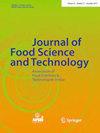Detecting a rapid method for measuring the proteolytic activity of raw and UHT milk.
IF 3.3
3区 农林科学
Q2 FOOD SCIENCE & TECHNOLOGY
引用次数: 1
Abstract
The relation between age gelation and proteolytic activity was investigated in this study, as proteolysis is considered to be one of the principal factors that cause gelation. Two different methods for measuring the proteolytic activity of milk samples were applied; the measurement of absorbance at 280 nm and the trinitrobenzene sulfonic acid (TNBS) method. The milk samples used were raw and UHT cow’s and goat’s milk. Proteolysis was also induced in UHT milk by inoculating cells of four different strains of Pseudomonas fluorescens into the milk and the changes taking place were observed. It has been found that the proteolytic activity of raw milk was not affected by a refrigerated storage for 10 days and only after this period it was gradually increased. The higher proteolytic activity of goat’s milk in comparison with cow’s milk during storage and its increased susceptibility to gelation were also established. Furthermore, the importance of storage temperature and the different effect of the four strains of P. fluorescens on proteolytic activity and pH of the UHT milk were shown. Finally, it has been demonstrated that there is a certain level of proteolytic activity in milk that leads to gelation when it is exceeded.一种快速测定原料奶和UHT奶蛋白水解活性的方法。
由于蛋白质水解被认为是导致凝胶形成的主要因素之一,因此本研究探讨了年龄凝胶形成与蛋白水解活性之间的关系。采用两种不同的方法测定牛奶样品的蛋白水解活性;采用三硝基苯磺酸(TNBS)法测定280nm吸光度。使用的牛奶样本是生的和UHT的牛奶和羊奶。在UHT牛奶中接种4种不同的荧光假单胞菌细胞,观察其蛋白水解的变化。研究发现,原料奶的蛋白水解活性在冷藏10天后不受影响,只有在冷藏10天后才逐渐提高。与牛奶相比,羊奶在贮藏过程中具有较高的蛋白水解活性,且易发生凝胶化。此外,还揭示了贮藏温度的重要性以及4株荧光假单胞菌对UHT乳蛋白水解活性和pH值的不同影响。最后,已经证明,牛奶中有一定水平的蛋白质水解活性,当超过该水平时,会导致凝胶化。
本文章由计算机程序翻译,如有差异,请以英文原文为准。
求助全文
约1分钟内获得全文
求助全文
来源期刊
CiteScore
7.70
自引率
0.00%
发文量
274
审稿时长
11 months
期刊介绍:
The Journal of Food Science and Technology (JFST) is the official publication of the Association of Food Scientists and Technologists of India (AFSTI). This monthly publishes peer-reviewed research papers and reviews in all branches of science, technology, packaging and engineering of foods and food products. Special emphasis is given to fundamental and applied research findings that have potential for enhancing product quality, extend shelf life of fresh and processed food products and improve process efficiency. Critical reviews on new perspectives in food handling and processing, innovative and emerging technologies and trends and future research in food products and food industry byproducts are also welcome. The journal also publishes book reviews relevant to all aspects of food science, technology and engineering.

 求助内容:
求助内容: 应助结果提醒方式:
应助结果提醒方式:


